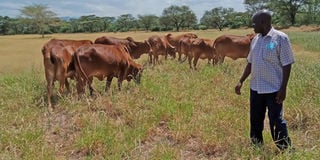How pasture farming has led to reduced cattle rustling

Mr David Biwott, who is in charge of livestock and pasture production at the Kerio Valley Development Authority (KVDA), looks on as a herd of Sahiwal cows graze at the authority's Chemeron Station in Marigat sub-county in Baringo County. African Foxtail Grass farming has reduced cattle rustling in the region.
What you need to know:
- In the vast Baringo County, cattle rustling, a cultural practice, has been rampant over the years.
- Pasture farming has helped reduce decades of pasture wars among the pastoralists.
One morning in mid-February, last year, Ben Lenariach, 47, drove his herd of cattle from Losogem village, along a footpath snaking west through shrubs.
He was headed to a grazing field by a river, which divides his Lchamus and the Pokot communities.
“Historically, there has always been tension here due to overgrazing, which has led to death and loss of livestock. You never know when an attack is going to happen. For years we have experienced a few days of peace in this region,” he narrates.
In the vast Baringo County, where the land is arid and rocky, the majority of Lchamus, Tugen and Pokot communities who live there have traditionally been livestock farmers. Families usually live in one place, while herders, mostly men, move in search of pasture and water.
Cattle rustling, a cultural practice, has been rampant over the years.
But an introduction to pasture farming and development in the region is proving to be a better way of curbing communal conflict that is highly fuelled by limited resources.
David Biwott, who is in-charge of livestock and pasture production at the Kerio Valley Development Authority (KVDA), says grass farming has reduced conflict as cattle herders like Lenariach no longer need to travel to far areas looking for the valuable resource for their livestock.
Livestock productivity
“African fox tail known scientifically as Cenchrus ciliaris is a perennial grass that forms spreading tufts. The grass is very palatable, strong, large and deeply rooted, therefore, can withstand a considerable amount of drought. It can also be cultivated for hay production,” says Biwott.
The grass was introduced to address declining pasture and livestock productivity as a result of a changing vegetation structure, declining diversity and increasing soil erosion. It has helped reduce decades of pasture wars among the pastoralists.
This communal pasture development has been embraced by cattle keepers like Joel Lemegiri and his extended family, with promising benefits. His cows now produce more milk leading to improved nutrition and food security like most other households engaging in fodder production in Marigat, Baringo County.
“Fodder availability throughout the year, even during drought periods, has lessened conflicts that were previously rampant,” he explains.
Biwott says KVDA is giving pasture seeds to pastoralists for fodder production because it also helps to combat land degradation and address their livelihood options.
“Pastoral communities in the lake Baringo basin use enclosures to restore indigenous vegetation as well as produce forage to meet deficits during the dry seasons. They are thus able to earn income from the sale of grass seeds to KVDA, hay and leasing out dry-season grazing,” he explains.





